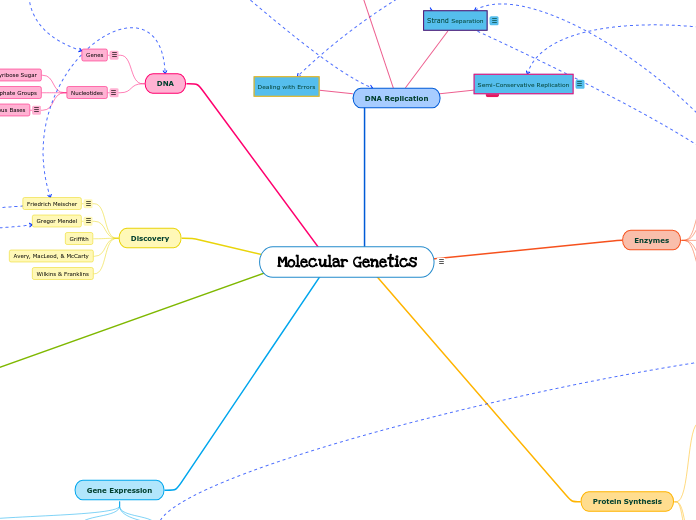Molecular Genetics
DNA Replication
Enzymes
Helicase
Topoisomerases
RNA Primase
RNA Primer
DNA Polymerases
I,II,III
Single-Strand Binding Proteins (SSBs)
One Gene-One Hypothesis
Protein Synthesis
RNA
mRNA
Precursor mRNA
Introns
Exons
Modified mRNA
Poly(A) Tail
5' Cap
mRNA splicing
Alternative Splicing
Small Ribonucleoprotein (snRNPs)
tRNA
Anticodons
rRNA
Ribosomes
Nucleotides
Ribose Sugar
Nitrogenous Bases
Purines & Pyrimidines
A, U, G, C
Phosphate Groups
Single-Stranded
Central Dogma
Transcription
Initiation
Promoter
TATA Box
RNA Polymerase
Building Complementary Strands
Elongation
Termination
Termination Sequence
Translation
Initiation
Elongation
Termination
Genetic Coding
Codons
Start Codons
Stop Codon
DNA
Genes
Nucleotides
Deoxyribose Sugar
Phosphate Groups
Nitrogenous Bases
Purine & Pyrimidines
Discovery
Friedrich Meischer
Gregor Mendel
Griffith
Avery, MacLeod, & McCarty
Wilkins & Franklins
Mutations
Point Mutation
Single Nucleotide Polymorphism (SNP)
Missense Mutation
Nonsense Mutation
Silent Mutation
Frameshift Mutation
Gene Expression
Transcriptional
Chromatin Remodelling Complex
Methylation
Post-transcriptional
Translational
Post-translational
Processing
Chemical Modification
Degradation
Hereditary Molecule
Complementary Base Pairings
A&T, G&C
Eukaryotic Cells
Semi-Conservative Replication
Strand Separation
Replication Origin
Building Complementary Strands
Dealing with Errors
Replication Fork
Replication Bubble
Causes
Spontaneous Mutation
Induced Mutation
Chemical Mutagen
